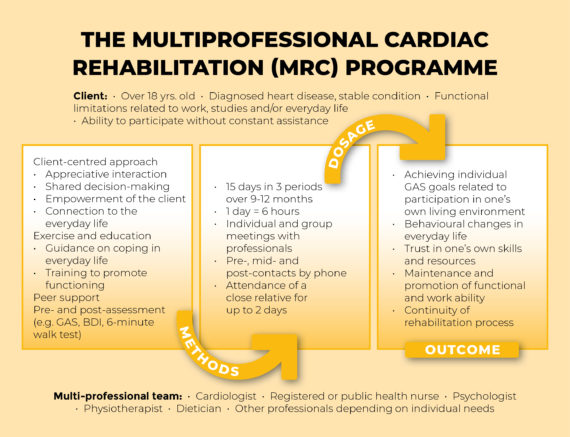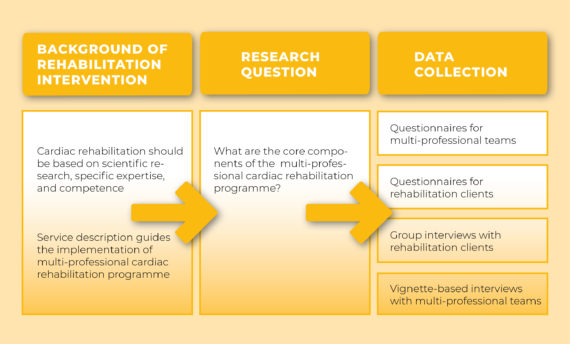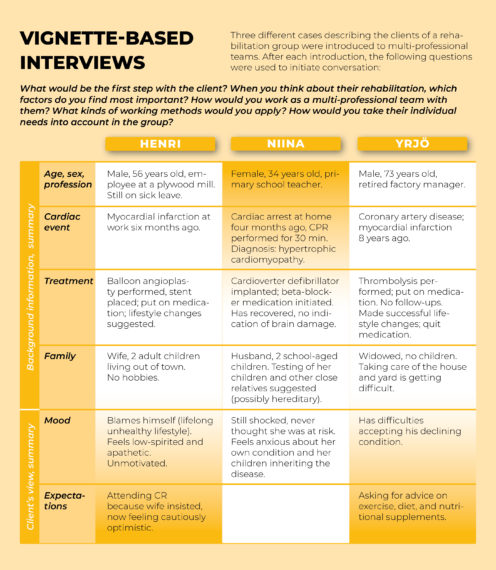A vignette-based interview is a useful method when investigating the core components of rehabilitation intervention. Understanding the core components requires a multi-perspective approach incorporating the viewpoints of both the clients and the professionals.
We have a pleasure to introduce a vignette-based interview in the poster presentation in Society for Implementation Research Conference ”From implementation foundations to new frontiers” in San Diego, California in September 8-10, 2022.
Background
Cardiac rehabilitation should be based on scientific research, specific expertise, and compe In Finland, the multi-professional cardiac rehabilitation (MCR) programme is organised by the Social Insurance Institution and carried out by local service providers in accordance with the instructions provided in the service description, which loosely defines the dosage and methods of intervention. According to the service description, cardiac rehabilitation is carried out in group format. However, the clients’ individual needs and goals guide the intervention.
This study applies the framework of Wierenga et al. (2012, 2013), combining the Consolidated Framework for Implementation Research (CFIR) and RE-AIM framework. It also applies a multi-method and multifaceted approach that provides information on the implementation, functionality, and outcomes of the intervention. Data sets are collected through electronic surveys and group interviews with the professionals and the clients. According to the mixed methods convergent design, the survey data and interviews are analysed separately before merging. The core components will be identified and compared with service descriptions based on mixed methods integrated data analysis.
Core components
Core components refer to the essential functions, principles, and intervention activities considered necessary to produce desired outcomes. When implementing intervention in real life settings, it is important to know which components of the intervention can be changed and modified and which should be kept unchanged. Usually, the efficacy of the intervention is studied as a whole, and the differentiating essential single elements are not addressed.
Defining the core components is part of intervention fidelity. Fidelity refers to the degree to which the ‘essential’ elements of an intervention are replicated ‘as intended’ during implementation. The essential elements can be related to, for example, methods, strategies, contents, and dosage of the intervention. The core components can be studied by combining literature and qualitative data from recognised experts, which can serve as a preparation for later empirical validation (e.g. the CORE [Components & Rationales for Effectiveness] Fidelity Method by Edmunds et al., 2022).
This study is based on two premises: First, different professionals may have different assumptions about which components of the intervention are the most important and why. Second, the core components of the MCR programme have not been adequately defined in the service description.
Vignettes as a method to investigate the core components
Vignettes were used in the interviews for two reasons: to trigger discussion and as a means to reveal the core components of the intervention. A vignette is a short narrative (case description) describing the situation of a hypothetical person. We presented three different Vignettes to the participants during an interview.
In a vignette-based interviewing process, a vignette is the structure that is used for collecting data. Therefore, the development of the vignette is crucial. In this study, the vignettes are based on joint understanding of service description and professional practice.
Results
In terms of investigating core components, the vignettes highlighted the differing needs of the clients, and the plausible narratives inspired multi-professional teams to discuss and describe their practices in a variety of situations.
Certain themes, such as nutrition and peer support, emerged repeatedly in interviews with both the professionals and the clients. At this stage of the analysis, the client perspective confirmed the professionals’ views on core components.
Conclusion
The study sheds light on the core components of the MCR programme. The arising core components support the client-centered implementation of the service description. The research findings help to understand the ‘black box’ of rehabilitation intervention.
Research team:
Sari Saukkonen, PT (1)
Maarit Karhula OT, PhD (1,2)
Hennariikka Heinijoki OT, MSc (1,2)
Riitta Seppänen-Järvelä, PhD (2)
1. South-Eastern Finland University of Applied Sciences, XAMK [firstname.surname@xamk.fi)
2. The Social Insurance Institution of Finland, Kela [firstname.surname@kela.fi]



